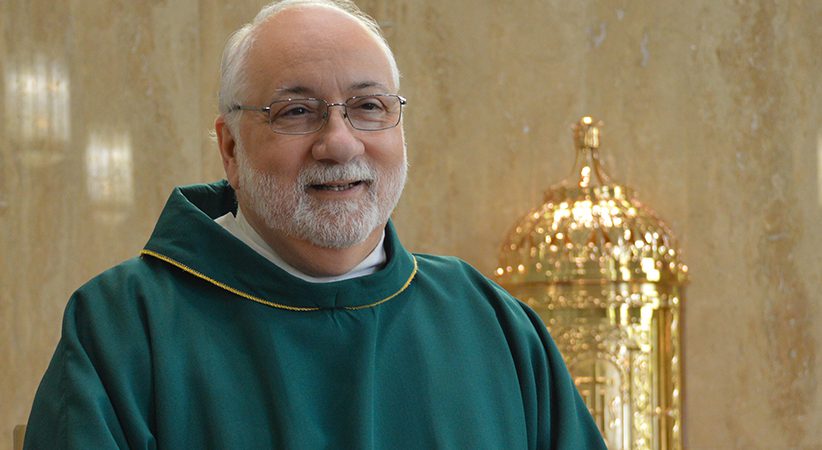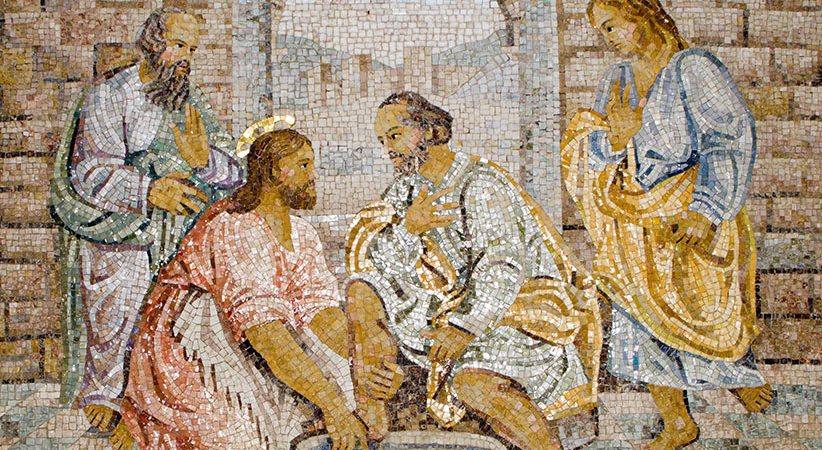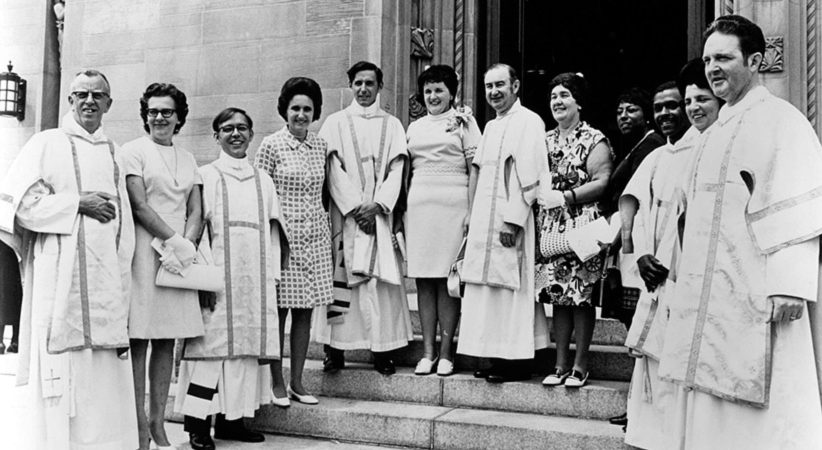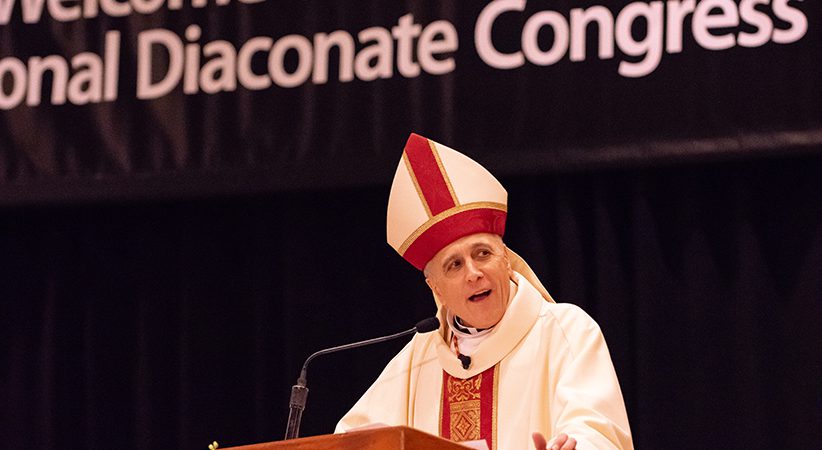Dealing with Addiction in Ministry
A deacon can be the person who helps guide the sufferer to God
Deacon Dan Giblin Comments Off on Dealing with Addiction in Ministry
Noah was tired. He had built the ark, populated it with two of every living creature, survived the flood, unloaded the ark and finally entered into a covenant with the Lord promising that creation would never again be wiped out. A brilliant rainbow appeared in the clouds as God’s covenantal signature.
After all of that, who could begrudge Noah a little downtime, a small celebration? Noah decided to have a drink. Incredible patience was necessary, however. Unfortunately, the Lord had not instructed Noah to bring two bottles of wine on the ark, so he had to plant a vineyard and wait.
Once his vineyard yielded enough grapes, Noah made some wine. He drank of the fruit of the vine, clearly too much, became intoxicated and passed out naked. Thus we have the first recorded occurrence of drunkenness in Scripture (cf. Gn 9:20-27).
While Noah’s drinking cannot be viewed as addictive, it does offer a foreshadowing of some of the behaviors, effects and consequences frequently seen in addiction. Noah displays unexpected, potentially immoral behavior before passing out. This incident resulted in shame, immorality, estrangement and the inception of generational punishment.
The framework of addiction is as old as the earliest stories in Genesis, even though the substance has changed from merely wine to an unending list of substances and behaviors.
Today, addiction is better diagnosed and interpreted by science rather than exegesis. However, the lessons of what occurred in Noah’s vineyard continue as part of the addiction story.
What Is Addiction?
Today we can differentiate between sinful misuse and addiction. The word addiction is derived from the Latin addicere, which means to adore or to surrender oneself to a master. Addiction to any substance or process (behavior as opposed to a substance) is a form of idolatry, submitting one’s self totally to a destructive force. This is not a freewill submission, as addiction removes the freedom of choice. In the words of the first step of the 12 steps of Alcoholics Anonymous (AA), we hear in part, “We admitted we were powerless. …”
According to the American Society of Addiction Medicine: “Addiction is a primary, chronic disease of brain reward, motivation, memory and related circuitry. Dysfunction in these circuits leads to characteristic biological, psychological, social and spiritual manifestations.”
While the scientific and spiritual worlds have advanced in addressing addiction, the number of substances and processes that can become addictive have skyrocketed. The current opioid epidemic dominates the headlines and is enslaving thousands of people who may have not been genetically or environmentally predisposed to become addicted to anything.
In 1956, the American Medical Association (AMA) declared addiction to alcohol and other drugs to be a disease. The criteria used was that the addiction is:
• Primary — the illness exists in and of itself
• Chronic — does not go away, heal spontaneously or remit
• Symptomatic — can be diagnosed by the way it manifests in a person’s physiology, behavior and lifestyle
• Fatal — if left untreated it will result in death
In 1991, the AMA endorsed the proposition that drug dependencies, including alcoholism, are diseases, and that their treatment is a legitimate part of medical and psychiatric practice.
As a Mental Illness
It may be predicted by genotype, the genetic constitution of an individual, and phenotype, the set of observable characteristics of an individual resulting from the interaction of its genotype with the environment. In other words, nature vs. nurture. Possessing these characteristics is not a certain predictor; potential does not mean it will happen. In addition, it can manifest itself at any point in life regardless of previous lifestyle or usage patterns.
Alcohol has the longest history of documented problematic use. The fields of medicine, psychology, psychiatry and religion have attempted solutions to alcoholism for centuries. Occasionally, there are short-term successes.
……………………………………………………………………………………………………………………………………………………….
According to the Centers for Disease Control,
an average of six people die every day in the United States from alcohol poisoning.
Binge drinking (four or more drinks for women; five or more for men) in a short period of time often leads to alcohol poisoning.
…………………………………………………………………………………………………………………………………………………………
However, it was not until the mid-20th century that a movement, which evolved from a Christian faith-based group, offered what has become the most well-known and arguably the most successful solution for alcoholism. The 12-step movement, as defined by Alcoholics Anonymous, and now used to address many other addictions, is by no means always successful, or the only avenue to freedom from addiction. For the faithful that deacons serve, however, it is unquestionably a program of recovery that we can support and integrate into the spirituality of our ministry.
The history of Alcoholics Anonymous offers a rich and inspirational story. Of particular interest to deacons in ministry is the spiritual requirement for long-term sobriety or abstinence.
Ministering to the Addicted
As deacons, we are configured to Christ the Servant. Questions we should ask ourselves before venturing into service to the addicted are: What do we believe, based on our lived experience as well as what we learn about addiction? Have we experienced addiction in our families? Do we sometimes wonder if it is not a self-inflicted problem that could be overcome with prayer and willpower? Can I practice empathy with the alcoholic, the heroin addict, or the person controlled by pornography or gambling?
An honest reality check on our own biases and prejudices in this area is necessary preparation. Otherwise, we may continue the belief that we are trying to convert an immoral person, instead of helping a sick person return to health.
The noted Swiss psychiatrist Dr. Carl Jung, while unsuccessfully treating an alcoholic, observed that there are some chronic alcoholics who are hopeless. However, he knew that for this chronic group there had been successes for those who experienced a “vital spiritual experience.” While religion — along with medicine, psychiatry and psychology — had struggled to cure alcoholics, it had not yet identified the need for all of those disciplines to work together and produce a spiritually-based program of treatment administered primarily not by professionals, but by the alcoholics themselves.
Jung’s hopeless patient happened upon the Oxford Group, a nondenominational Christian movement. Oxford Group members experienced great lifestyle changes with issues such as prostitution, gambling and adulterous lifestyles. However, their greatest unexpected accomplishment was with alcoholics. The Oxford Group message eventually made its way to a man named Bill Wilson, one of the two founders of Alcoholics Anonymous.
Wilson was impressed by the sobriety displayed by followers of the Oxford Group tenants but was resistant to the religious aspect. It was suggested to Wilson that he forgo any previous religious beliefs and adopt his own interpretation of God. Shortly thereafter, he had a spiritual awakening while experiencing one of many hospitalizations for his drinking. After he began attending Oxford Group meetings, he never drank again.
Trust God
The 12 steps offer a journey out of self for the person seeking freedom from the bondage of addiction and movement toward others and a God of their understanding. A frequently heard phrase summarizing the 12 steps is “Trust God, Clean House, and Help Others.”
Proposing a spiritual base of “God as I understand him” allowed the alienated, unchurched, agnostic or atheist sufferer to avail themselves of the program while imposing no particulars on how God was defined. Many members chose to view God, or a power greater than themselves, simply as a group of people successfully living their lives free from their addiction — something a potential member could not do by themselves.
Alcoholics Anonymous, and consequently all fellowships that use the 12-step model of recovery, allows every member the opportunity to grow spiritually in a manner that supports their sobriety or abstinence. It is suggested that members learn from religion and, when possible, and if desired, return to the religion of their choice.
However, while anonymous fellowships have no official opinion on the religious involvement of its members, a frequently heard sentiment in meetings is the “spiritual not religious” position, even to the point of denigrating organized religion. While this tends to reflect the view of secular society, it also offers the Church, and specifically deacons, a wonderful opportunity for evangelization.
Members are often easily resistant to religion but have difficulty in fleshing out what spirituality actually means. They fail to see that any spirituality must have an object. As one progresses in recovery the need to supply specificity to the object of the spirituality increases. With an understanding of the broadly undefined nature of God that helps many in early recovery, we can begin to minister to fill the God-shaped hole with an awareness of the danger of prematurely imposing the fullness of the faith — a task sometimes compared to feeding spiritual steak to babies.
None of this is meant to denigrate the spirituality of the 12-step fellowships. While the spirituality of our faith leads us to a closer relationship with Christ and hope for eternal salvation, the spirituality of recovery provides hope, on a daily basis, for the continuation of a physical life free from the bondage of substances of behaviors.
Twelve-step spirituality has been called the greatest spiritual movement of the 20th century, and Franciscan Father Richard Rohr has called it “America’s unique contribution to the history of spirituality.”
While some in the recovery movements may denigrate organized religion, we cannot fall into the same trap of considering the 12 steps as just an oversimplified spiritual self-help movement.
AA defines alcoholism as “an illness which only a spiritual experience will conquer.” Members maintain that their addiction is not consciously chosen and therefore should not be termed “sin” in the proper sense. They make a distinction similar to that which Catholics make between original and actual sin. The Catechism of the Catholic Church explains this as follows: “By yielding to the tempter, Adam and Eve committed a personal sin, but this also affected the human nature that they would transmit to their offspring in a fallen state. That is why original sin is called ‘sin’ only in an analogical sense: it is a sin ‘contracted’ and not ‘committed — a state and not an act” (No. 404).
Catholicism has played an important role in the history of recovery fellowships and its spirituality. Jesuit Father Edward Dowling had heard about the existence of AA and its success with alcoholics. While AA was still in its infancy, he learned of an AA group that was located in Chicago, and in the fall of 1940 he traveled from his home in St. Louis to investigate these miraculous testimonies.
After observing the AA group in Chicago, and convinced by the successes they had witnessed, Father Dowling returned to St. Louis and established the first AA group in that city.

Father Dowling was intrigued by what he saw as a similarity of the 12 steps to the Spiritual Exercises of St. Ignatius. He traveled to New York to meet Bill Wilson and inquired if Wilson’s writings had been influenced by Ignatian spirituality. While Wilson was not familiar with the Ignatian Exercises, a friendship developed with Father Dowling. Wilson was undoubtedly influenced by Dowling’s faith and Catholic theology. Until Father Dowling’s death in 1960, Wilson considered Father Dowling to be his spiritual sponsor.
Undoubtedly, it was Father Dowling’s friendship and lived example of the Catholic faith that led Wilson to consider conversion to Catholicism. During the summer of 1947, Wilson took instructions in the Faith from then Msgr. (later Bishop) Fulton J. Sheen for about a year, but he reportedly lost interest in his conversion due to his AA responsibilities. His awareness of the effect that his conversion would have on AA was almost certainly a consideration.
A common tradition in recovery groups is the granting of medallions to mark the length of time spent sober or abstinent. This custom also has Catholic roots. Sister Ignatia Gavin, a Sister of Charity, was an early ally of Dr. Bob Smith, helping admit alcoholics into St. Thomas Hospital in Akron, Ohio. Upon their discharge, Sister Ignatia would give the newly sober alcoholics a Sacred Heart cloth badge. She would request that if the person should be tempted to drink he should return the badge before taking the drink, thereby giving her a chance to talk the person out of losing their sobriety.
The patron saint of alcoholics is the Venerable Matt Talbot, a hopeless alcoholic who achieved sobriety through a robust spiritual life in early 20th-century Ireland. He began his relationship with the Lord by “taking the pledge” to a God with which he had no personal experience. He deepened his relationship with God by sitting in the back of churches instead of stopping into pubs when he was tired and seeking rest. His life mirrors many of the spiritual activities that comprise a 12-step recovery.
Stepping Out to the Fringes
A theme of Pope Francis’ papacy has been his call for the Church to reach out to the peripheries and the fringes of society. The stigma of addiction creates a unique fringe group. Our diaconal ministry of charity, and closeness to the faithful, calls us to address the epidemic level of addiction today.
In Deus Caritas Est, Pope Benedict XVI said, “Being a Christian is not the result of an ethical choice or a lofty idea, but the encounter with an event, a person, which gives life a new horizon and a decisive direction” (No. 1). This accurately describes the encounter that a person experiences when entering recovery. At some point, God, as they understand him, seeks a relationship with them and offers the gift of recovery. Recovering people initially seek the gifts and consolation of an unfamiliar God, but eventually will seek a deeper relationship with the God of consolation.
In the Church, a deacon can be that person who helps guide the sufferer to that new horizon. We can participate in a conversion or turning away from personal destruction toward physical life itself, and a new spiritual life with God. Our role is to support, not to replace, their 12-step or counseling activities.
We can start by recognizing our own status as wounded healers. Who cannot identify with St. Paul when he said, “What I do, I do not understand. For I do not do what I want, but I do what I hate” (Rom 7:15)?
The 12 steps are rooted in Christian spirituality. We can see evidence of the first two steps again from St. Paul in 2 Corinthians 12: “Three times I begged the Lord about this, that it might leave me, but he said to me, ‘My grace is sufficient for you, for power is made perfect in weakness.’ I will rather boast most gladly of my weaknesses, in order that the power of Christ may dwell with me. Therefore, I am content with weaknesses, insults, hardships, persecutions, and constraints, for the sake of Christ, for when I am weak, then I am strong.”
In 1961, Wilson wrote to Dr. Jung to acknowledge his contribution to the success of AA through his observation about a spiritual experience being necessary for some. In Jung’s reply to Wilson he stated: “You see, ‘alcohol’ in Latin is ‘spiritus’ and you use the same word for the highest religious experience as well as for the most depraving poison. The helpful formula, therefore, is spiritus contra spiritum.”
Spiritus contra spiritum translates to “spirit against spirit.” With the spirit of addiction, there is the battle with the Holy Spirit within the person, even if they are unaware of their own spirituality.
Through our ministry as deacons, we offer the Spirit of the Divine, especially with our charism of charity. Our order of deacons was founded on serving the unserved, the Hellenists. The language was the barrier that separated that group of believers from the Hebrew-speaking church. It is incumbent on us today to learn the language, and spirituality, of addiction recovery, so that we can continue to reach out to those who are separated by addiction from God. All of them suffer and many perish because of this separation.
Deacon Dan Giblin is a deacon of the Archdiocese of Philadelphia, a Certified Recovery Specialist, Recovery retreat director and works as a spiritual adviser at the St. John Vianney Center in Downingtown, Pennsylvania.
……………………………………………………………………………………………………………………………………………………………
The Story Behind the 12 Steps
Once, while on a business trip, Bill Wilson experienced a great desire to drink. He sought out another alcoholic to help as a way of avoiding the temptation to drink. The alcoholic he found was Dr. Bob Smith, the other acknowledged founding member of Alcoholics Anonymous. He shared with him his experience with alcohol, which Dr. Bob could easily relate to, and he was offered a simple spiritual solution: admitting powerlessness, dependence on God and working with other alcoholics.
After successfully offering their solution to many other alcoholics, they decided to separate from the Oxford Group so that all their efforts could be devoted to alcohol and to remove any religious dogma that could possibly exclude or alienate someone from accepting their solution.
Over time, the founding members identified six steps to recovery.
• We admitted that we were licked, that we were powerless over alcohol.
• We made a moral inventory of our defects or sins.
• We confessed or shared our shortcomings with another person in confidence.
• We made restitution to all those we had harmed by our drinking.
• We tried to help other alcoholics, with no thought of reward in money or prestige.
• We prayed to whatever God we thought there was for power to practice these precepts.
When the fledgling organization assumed the task of authoring a basic textbook of how their program worked, Wilson expanded the six steps to the 12 steps as they exist today.
………………………………………………………………………………………………………………………………………………………….





